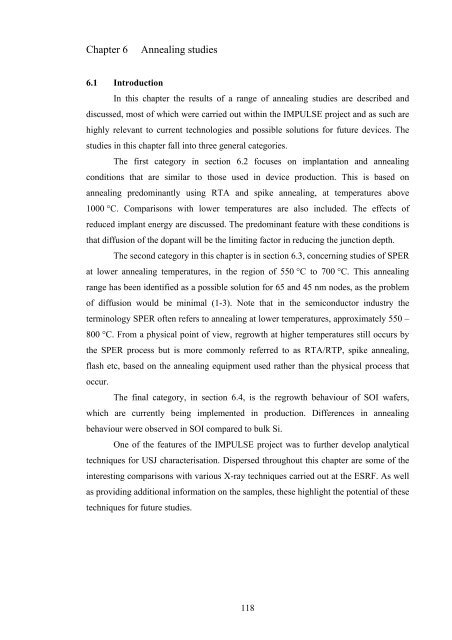Damage formation and annealing studies of low energy ion implants ...
Damage formation and annealing studies of low energy ion implants ...
Damage formation and annealing studies of low energy ion implants ...
Create successful ePaper yourself
Turn your PDF publications into a flip-book with our unique Google optimized e-Paper software.
Chapter 6 Annealing <strong>studies</strong><br />
6.1 Introduct<strong>ion</strong><br />
In this chapter the results <strong>of</strong> a range <strong>of</strong> <strong>annealing</strong> <strong>studies</strong> are described <strong>and</strong><br />
discussed, most <strong>of</strong> which were carried out within the IMPULSE project <strong>and</strong> as such are<br />
highly relevant to current technologies <strong>and</strong> possible solut<strong>ion</strong>s for future devices. The<br />
<strong>studies</strong> in this chapter fall into three general categories.<br />
The first category in sect<strong>ion</strong> 6.2 focuses on implantat<strong>ion</strong> <strong>and</strong> <strong>annealing</strong><br />
condit<strong>ion</strong>s that are similar to those used in device product<strong>ion</strong>. This is based on<br />
<strong>annealing</strong> predominantly using RTA <strong>and</strong> spike <strong>annealing</strong>, at temperatures above<br />
1000 °C. Comparisons with <strong>low</strong>er temperatures are also included. The effects <strong>of</strong><br />
reduced implant <strong>energy</strong> are discussed. The predominant feature with these condit<strong>ion</strong>s is<br />
that diffus<strong>ion</strong> <strong>of</strong> the dopant will be the limiting factor in reducing the junct<strong>ion</strong> depth.<br />
The second category in this chapter is in sect<strong>ion</strong> 6.3, concerning <strong>studies</strong> <strong>of</strong> SPER<br />
at <strong>low</strong>er <strong>annealing</strong> temperatures, in the reg<strong>ion</strong> <strong>of</strong> 550 °C to 700 °C. This <strong>annealing</strong><br />
range has been identified as a possible solut<strong>ion</strong> for 65 <strong>and</strong> 45 nm nodes, as the problem<br />
<strong>of</strong> diffus<strong>ion</strong> would be minimal (1-3). Note that in the semiconductor industry the<br />
terminology SPER <strong>of</strong>ten refers to <strong>annealing</strong> at <strong>low</strong>er temperatures, approximately 550 –<br />
800 °C. From a physical point <strong>of</strong> view, regrowth at higher temperatures still occurs by<br />
the SPER process but is more commonly referred to as RTA/RTP, spike <strong>annealing</strong>,<br />
flash etc, based on the <strong>annealing</strong> equipment used rather than the physical process that<br />
occur.<br />
The final category, in sect<strong>ion</strong> 6.4, is the regrowth behaviour <strong>of</strong> SOI wafers,<br />
which are currently being implemented in product<strong>ion</strong>. Differences in <strong>annealing</strong><br />
behaviour were observed in SOI compared to bulk Si.<br />
One <strong>of</strong> the features <strong>of</strong> the IMPULSE project was to further develop analytical<br />
techniques for USJ characterisat<strong>ion</strong>. Dispersed throughout this chapter are some <strong>of</strong> the<br />
interesting comparisons with various X-ray techniques carried out at the ESRF. As well<br />
as providing addit<strong>ion</strong>al in<strong>format<strong>ion</strong></strong> on the samples, these highlight the potential <strong>of</strong> these<br />
techniques for future <strong>studies</strong>.<br />
118
















